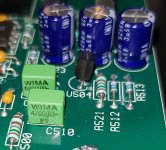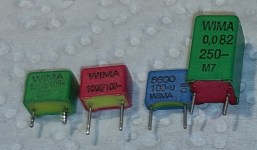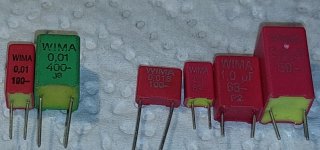In some prevoius period of production they were green, now they are red.
Some sellers purchased quantities years ago and still sell them, green FKP2's.
If these were tubes a "NOS" label would apply.
Work good, just as the red ones.
Some sellers purchased quantities years ago and still sell them, green FKP2's.
If these were tubes a "NOS" label would apply.
Work good, just as the red ones.
There are some datasheets in the archives:
https://docs.rs-online.com/a220/0900766b801602f0.pdf
Distinction was made between case color, epoxy color and print (marking) color.
Due to the general change to red cases, various types exist and are still available.
In general: Black print => better quality
https://docs.rs-online.com/a220/0900766b801602f0.pdf
Distinction was made between case color, epoxy color and print (marking) color.
Due to the general change to red cases, various types exist and are still available.
In general: Black print => better quality
Attachments
Last edited:
FKC, the yellow ones! Quite good too just like MKC which I still have. Polycarbonate simply was good but it was pushed from the market.
It wasn't a stable product in contact with the air and they couldn't make it work over 250v dc i think...Still have some and also some pink ero mkc .
Attracting moist is a property of polycarbonate but these caps were molded in resin so no issue. Of course when a product is cancelled some negative things will be exaggerated and a new material with superior properties will be presented. That is marketing...
The sole reason it was cancelled is that there was just 1 manufacturer (Bayer) of the foil and that manufacturer stopped production of the foil.
The sole reason it was cancelled is that there was just 1 manufacturer (Bayer) of the foil and that manufacturer stopped production of the foil.
Last edited:
Fkc was the first small cap able to replace polysterene which used to take too much space but none of the modern types was up to polystyrene capabilities if you ignore size.Some mitsubishi and matsushita poliester foil caps do better than polypropilene in high strain circuits like high power inverters as it seems that mylar is better at damping mechanical resonances than polypropilene at equivalent max voltage as it's dielectric is thicker, but not better than polystyrene.
Last edited:
Coincidentally I ran into my old stock and found EMZ/Philips/Siemens/Mial/RIFA molded KS, Molded silver mica etc. When stuff is molded in resin it lives quite long.
"Open" polystyrene caps crack unfortunately (depends on brand).
Here an old WIMA datasheet explaining the series by means of casing color, resin color and print color:
"Open" polystyrene caps crack unfortunately (depends on brand).
Here an old WIMA datasheet explaining the series by means of casing color, resin color and print color:
Attachments
I only see the new notation...
Anyway i'm not very proud myself of foraging for years and having about 100kg of unused capacitors of all types...
Anyway i'm not very proud myself of foraging for years and having about 100kg of unused capacitors of all types...
PP isn't good at that either, even when potted in epoxy. Research was made in my company and we had significantly higher failure rate in "tropical" conditions with (TDK, HJC) MKP X2 caps there (of course that intersects with the generally poorer grid quality in those countries - having more surges due to weaker grid stability) - application: PV inverters.Attracting moist is a property of polycarbonate but these caps were molded in resin so no issue. Of course when a product is cancelled some negative things will be exaggerated and a new material with superior properties will be presented. That is marketing...
The sole reason it was cancelled is that there was just 1 manufacturer (Bayer) of the foil and that manufacturer stopped production of the foil.
Last edited:
Those are the same red WIMA's you already know. They are just not ripe yet. (sorry, I couldn't resist).
There is not much that stays OK in such environments. However when used in moderate (well, things are changing) climates then one won't experience much trouble. For sure less trouble than with the same caps not molded 🙂 The devices I work with have been treated with a kind of resin and all parts are coated/molded in that to prevent such trouble.PP isn't good at that either, even when potted in epoxy. Research was made in my company and we had significantly higher failure rate in "tropical" conditions with (TDK, HJC) MKP X2 caps there (of course that intersects with the generally poorer grid quality in those countries - having more surges due to weaker grid stability) - application: PV inverters.
Now what was the main cause for higher failure? High moist or surges of the grid? And what about mains frequency?
I've to correct myself, they were FKPs and the QC for the metal foil failed. Some impurity that lead to more oxidation during production of the caps that had negative effects after potting as well. But as a side result, they've discovered that potting isn't a ultimate shield against humidity.Now what was the main cause for higher failure? High moist or surges of the grid? And what about mains frequency?
Aha no not when oxidation continues within the potting as the product has defects. I doubt though if the potting can be blamed when the foil itself has issues like oxidation from within. It wouldn't need the moist to oxidize.
Well, J-P, that was the results. Even the finest quality caps suffered from high humidity environment - in AC X2 application. Of course I'm not blindsighted to question any low voltage audio application to suffer from these defects - But then, who knows - some would still find negative effects 😉
High humidity is not only nasty to parts. I never forget the first time I experienced the “wet-towel-in-your-face” feeling when leaving the airplane. Then the sweating starts until it seems you have fallen in a swimming pool fully clothed.
Ah, the choice of color for Polyester!
What to wear, what to wear.....
Red is so slutty, and green is more attractive.
And white shoes after Labor Day is definitly out.
What to wear, what to wear.....
Red is so slutty, and green is more attractive.
And white shoes after Labor Day is definitly out.
- Home
- Design & Build
- Parts
- Green WIMAs: polyester or something else ?


